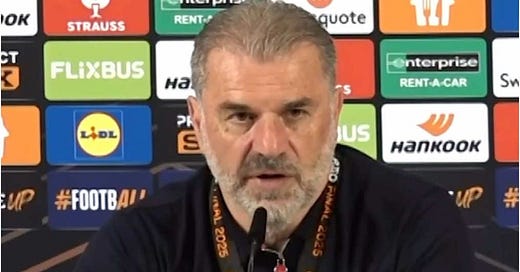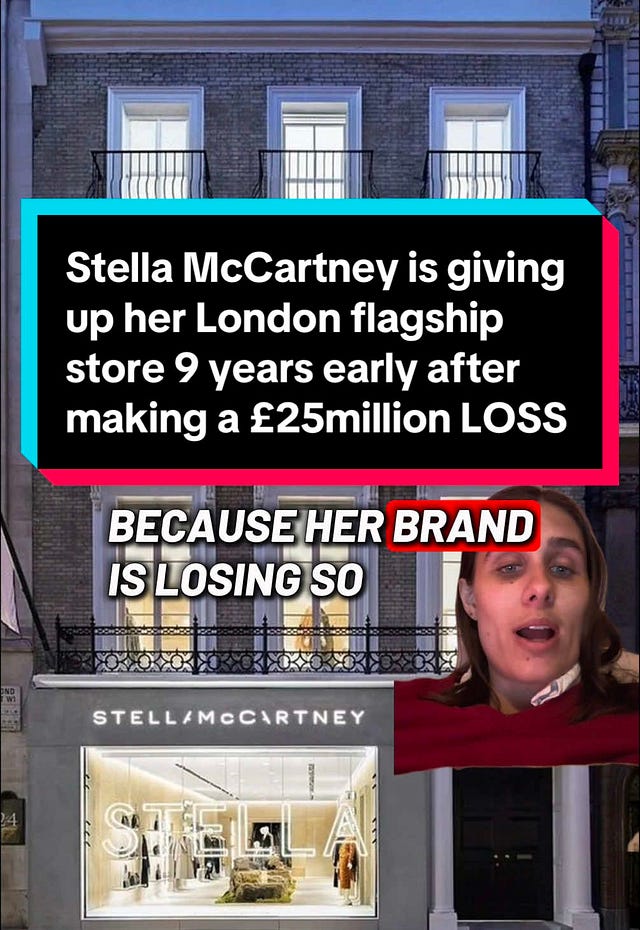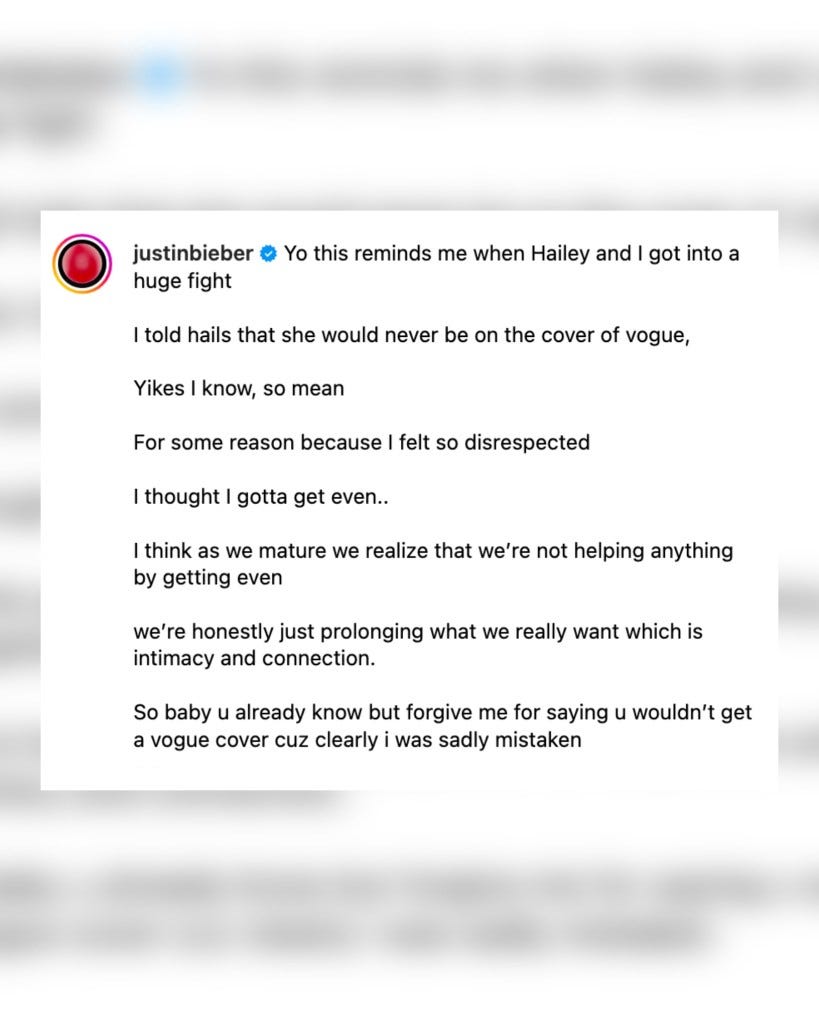Borkowski Media Trends: Big Ange's Master Plan, Has Ramaphosa shown us how to top Trump? & MORE
PLUS: Glasto's World of Yurt | Is Stella getting canned? | Biebs' Caption Catastrophe
Expectation Management or Brinksmanship? Big Ange’s Master Plan
Tottenham Hotspur's triumph has been plastered across the front pages for good reason. It was a showdown with all the right ingredients: a high-stakes affair with an edge of desperation. While Tottenham is considered a 'big six' club, silverware had escaped them for over 15 years and it's been a calamitous league season with Spurs just hovering above the relegated teams.
Flip the coin and Manchester United sit one spot above Spurs in the league - a terrible situation for a global sporting superpower who've made a habit of winning the odd trophy to mask their decline. For both clubs, their season came down to this moment - win and hail success, lose and face unmitigated financial disaster and reputational disaster.
In the lead-up, press attention locked onto Tottenham's manager Ange Postecoglou whose relationship with the media has been tumultuous. When he joined in 2023, his interview style was refreshingly forthright, akin to chatting to reporters in a pub setting. However, when results declined, rapports soured culminating in a wild gambit, declaring he "always win things in my second year". So the pressure was firmly on Ange and this all-or-nothing affair - heightened by a viral bicker with a journalist calling him a "clown" (while the football community evidenced this was indeed true, the journalist didn't write it himself - it appeared in the article's headline, which is penned by the sub-editors and not the journalist).
Staking your reputation on the promise of something you can’t control like this is ill-advised. While the brinksmanship worked as a form of expectation management, alleviating all this pent-up pressure for now, the line between hero and zero was vanishingly thin. Perhaps Ange was ready to take on such a disastrous and embarrassing alternate reality, we'll never know. But when these moments can be captured in infamy through social media, you must have a serious mettle to compete in these waters. This of course is what makes communications in top level sport so fascinating.
Has Ramaphosa shown us how to top Trump?
Another week another piece of Oval Office theatre but unlike President Zelensky who was blindsided by the public dressing down he received from President Trump and Vice President Vance, South African President and certified wily old fox Cyril Ramaphosa came at least partially prepared.
An excellent BBC News article by Gary O’Donoghue wasn’t explicitly about the PR and communications strategies but summarised Ramaphosa’s mitigation tactics perfectly.
Firstly, he knew what was coming; although no longer flavour of the month in the White House, Elon Musk’s influence remains and the President’s advisor has been using X in recent weeks as a platform to spread the myth of ‘white genocide’ in South Africa. X is now generally a fair representation of the MAGA state of mind (even if its own AI sometimes fails to toe the line) and so Ramaphosa must have suspected that Trump might use his visit as a soapbox to advocate for the rights of his base of conservative white men.
So Ramaphosa dampened the potential aggression with a distraction technique. He came flanked by legendary golfers Ernie Els and Retief Goosen. As a golf nut Trump could not hide his excitement. It was a lengthy sideline and shift in tone from the planned attack.
When the ambush did come Ramaphosa stuck to a combination of the Fabian Strategy and an armadillo-like defence and simply absorbed most of the criticism, using his (white, Afrikaner) compatriots as a shield in one moment of polite deflection: “If there was Afrikaner farmer genocide, I can bet you, these three gentleman would not be here."
It was still a bruising encounter even for a statesman whose experience harks back to the end of apartheid, but it showed foreign leaders that there is a way of dampening the impact of Trump’s Oval Office kettlings which might force the US President into a rethink.
Glasto’s World of Yurt
Ah, Glastonbury. A place of music, mud, and magical memories. Provided, of course, you actually get in. For some would-be festivalgoers, dreams of sipping rosé in the safety of a luxury yurt have just collapsed like a poorly pitched tent in a rainstorm.
Yurtel, the high-end glamping company known for charging near the price of a deposit on a house for a weekend of posh portaloos and artisan pillow mints, has officially gone bust. Gone with the Glasto wind. The result? A chorus of distraught customers, many of whom shelled out up to £16,500 for a “once-in-a-lifetime” experience, now left with neither yurts nor tickets, just a very expensive email thread and the bitter taste of direct bank transfers.
One customer, Lydia, was “absolutely gutted,” which in British translates to “wailing into a feather-stuffed cushion while Googling small claims court.” She paid ten grand (plus VAT, naturally) and said paying by credit card wasn’t allowed, which some may have seen as a red flag. A few others echoed the sentiment, their dreams of deluxe compost toilets now compost themselves.
Glastonbury, meanwhile, issued a polite statement, essentially saying, “Yurtel who? Not our circus, not our glamping catastrophe.”
So, what’s the moral of the story? It’s bad PR for third-party suppliers all round. One bad apple makes the whole public suspicious. If you’re going to gamble five figures on a luxury tent in a Somerset field, the logic will go, at least make sure it comes with a receipt, and maybe a refund policy. Failing that, would it be too much to ask that they embrace the true spirit of Glasto? Pop-up tents, a rain poncho, and a healthy distrust of luxury (and of course, mud) are all part of the spirit of what makes Glastonbury such a special part of British culture. No one is denying the unfairness of the situation, but it is difficult to find sympathy for those seeking a Coachella experience where your average Coachella-goer would unlikely last a day.
Is Stella getting canned as the sustainable fashion Kingpin?
This week, iconic British brand Stella McCartney has found itself at the centre of speculation, with rumours circulating that the clothing label may be going out of business. Company filings from 2023 revealed that the brand posted a pre-tax loss of £25 million, £10 million more than the previous year. Now in May, it was announced that the Old Bond Street flagship store would be closing its doors. The question now is whether the famous daughter of Paul McCartney is facing a crisis or simply repositioning for the future of her brand.
Stella McCartney is a businesswoman at her core, having successfully built a brand empire centred around sustainability and cruelty-free, vegan materials. After selling a minority stake to luxury conglomerate LVMH in 2019, she remarkably bought it back in January this year, regaining full control. While headlines swirl with rumours about financial trouble, McCartney has kept a low profile, and quietly reclaimed her company, thus making decisions any strategic entrepreneur would. If that means closing a flagship store in a changing retail landscape, so be it.
Some industry experts suggest McCartney is steering her brand further into the digital age. Her longstanding commitment to sustainability remains at the heart of her business, and this may be a strategic pivot. With fewer consumers frequenting physical stores, maintaining a physical flagship holds little to no relevance in today’s fashion industry.
Stella McCartney remains a respected name in fashion. The brand has weathered the test of time, and with McCartney’s personal legacy and connections, chance are it’s not going anywhere. McCartney is successfully choosing quiet action over noise and that’s exactly what she should be doing, especially when rumours and headlines of bankruptcy and uncertainty are published. McCartney is very much in control of her narrative.
The Biebers: The Cover, His Caption, and Her Comeback
Hailey Bieber should have been enjoying her Vogue US cover moment, a fashion-world accolade often read as a sign of cultural favorability and personal momentum. But the moment was quickly muddied by her husband. Justin Bieber’s Instagram tribute was less celebration, more self-reflection: a meandering caption recounting a past fight in which he cruelly told her she would “never be on the cover of Vogue” and ending “Baby, u already know, but forgive me… clearly I was sadly mistaken.” Intended as a gesture of growth, it came off as emotionally clumsy and, crucially, drew attention away from her achievement.
The timing didn’t help. Hailey has spent months in the internet crosshairs, accused of shading Justin’s ex-girlfriend Selena Gomez on TikTok and picked apart in a viral theory casting her as a manipulative interloper obsessed with her husband and his ex. The Vogue cover offered a chance to reset the narrative, and she took it.
In Vogue’s ‘What’s In My Bag’ YouTube series, a format usually reserved for soft charm and sponsored product placement, Hailey flipped expectations. She delivered a dry, self-aware monologue laced with barbs aimed squarely at her online critics. Out came several burner phones “for commenting, stalking, viewing girls’ pages, making multiple accounts.” Then a perfume called Eau d’Nepo “I’ve been wearing this my entire life... it really does all the work for you.” Finally, a tincture from a mountain witch, allegedly acquired at age 12, designed to “make a Canadian pop star fall in love” with her.
It was a controlled demolition of the narratives around her, deliberate, hilariously satirical, and executed with enough deadpan poise to be instantly memeable. The response from press and fans alike was warm.
Ultimately, while her husband’s caption reignited old suspicions, Hailey emerged sharper, more self-possessed, and firmly back in favour, this time by getting the joke in before anyone else could.






